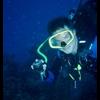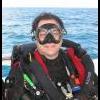
DIN and Yoke - regulators and tanks
#1

Posted 22 August 2006 - 10:36 AM
Why does it matter? How about:
When you are renting a tank - you want to make sure you reserve the right valve/tank for your regulator
(or the reverse)
When traveling you want to make sure you have the proper regulator for the tanks you will be renting or know how to ask for the options
(or)
When renting both regulator and tank, you may want to get the one you are used to assembling/diving
So who can share some info regarding explaining the differences between the two, perhaps even the history behind them, why there are the two, when a diver would select one over the other, and can one be converted into the other easily?
Once in a while, it is good to step back, take a breath, and remember to be humble. You'll never know it all - ScubaDadMiami. If you aren't afraid of dying, there is nothing you can't achieve - Lao-tzu. One dog barks at something, the rest bark at him - Chinese Proverb.
#2

Posted 22 August 2006 - 10:53 AM

DIN tank valve (a memory phrase I use in teaching with DIN regulators as divers are setting up their gear is "DIN screws IN"):

Once in a while, it is good to step back, take a breath, and remember to be humble. You'll never know it all - ScubaDadMiami. If you aren't afraid of dying, there is nothing you can't achieve - Lao-tzu. One dog barks at something, the rest bark at him - Chinese Proverb.
#3

Posted 22 August 2006 - 10:59 AM
DSSW,
WWW™
#4

Posted 22 August 2006 - 11:02 AM
The particle tube, or dip tube as referred to by some (the cylindrical tube jutting out of the bottom of the valve as seen in the first image above) is just simply not in the image in the second one above. It looks as though the image truncated it. That's all.Shouldn't they both have particle tubes?
So, lend us some Yoke/DIN info Walter?
Once in a while, it is good to step back, take a breath, and remember to be humble. You'll never know it all - ScubaDadMiami. If you aren't afraid of dying, there is nothing you can't achieve - Lao-tzu. One dog barks at something, the rest bark at him - Chinese Proverb.
#5

Posted 22 August 2006 - 12:07 PM
Edited by Walter, 22 August 2006 - 12:09 PM.
DSSW,
WWW™
#6

Posted 22 August 2006 - 12:29 PM
As for overall popularity, I was under the impression that DIN is more popular overseas, whereas in the US and Canada, yoke prevails. True or false? (My impression is based on recreational divers.)
#7

Posted 22 August 2006 - 12:36 PM
DSSW,
WWW™
#8

Posted 22 August 2006 - 01:01 PM
Also there are two types of DIN. One is the 232bar. It has 5 threads. There is also a 300bar DIN. It has 7 threads. The 232bar can accept a small screw-in unit that will change this type of tank valve to yoke. That is not possible with the 300bar units. If you have a 300bar DIN regulator (nearly all modern DIN regs are 300bar) you can screw your DIN reg into either a 300bar DIN connection or a 232bar DIN connection.
Why all this confustion? In Europe, the some tanks are designed to handle more pressure than we use in the US. This is a fairly recent development. To handle the newer tanks, new valves were needed. The problem was that many of the older regulators were not able to handle the new high pressures of the tanks. So some system needed to be developed to ensure that an older 232bar regulator was not screwed into a new 300bar DIN valve, creating a potential safety hazard. The 300bar DIN valve was made longer. This way, a 232BAR regulator WILL screw in, but will not reach the back of the valve and thus will not seal. So you turn the tank on and the gas (air) just escapes safely.
Older yoke systems were not designed to handle the new higher pressures of todays HP steel tanks. They were designed for the 2640-3000psi of older tanks. The new 3442psi tanks can put undue pressure on them and cause cracking or catastrophic failure. I don't need to tell you what happens if your yoke connection breaks catastrophically inches from the back of your spine. Not pretty. So technical divers, or those using higher pressure tanks, insist on DIN. There are other reasons as well. If you look at a diver wearing a yoke regulator system as they swim along in the water, you'll notice the yoke screw handle sticks up. This makes a PERFECT place for line, or fishing line, to get wrapped around. It's hard to fix yourself because you can't see it and it's awkward to reach. Putting your knife back there blindly is problematic because of the proxmimity of the hoses. A DIN connection has no such protrusion and line can pass safely over the diver.
There's slightly more to the story, but I'll leave it there. Perhaps others will add more.
I'd be curious to know which is more popular with recreational divers, especially in tropical destinations. Also, how easy -- if even possible -- is it to change one's reg from one system to the other. What happens if you're diving somewhere where your usual set-up is NOT the norm? Can you adapt your reg right then and there?
(Assuming you didn't do your research before you left home.)
#9

Posted 22 August 2006 - 01:32 PM
My dive shop predominantly uses DIN regs and tanks., however, our rental fleet of steel HP 80 tanks all have convertible valves. That means that you can screw in a plug, which has a fatter O-ring on each side of the plug, into the tank valve converting the valve from a DIN to a yoke allowing for a yoke regulator. We have a few (less than 5) yoke regulators in rental. Almost all of the dive professionals in the shop dive DIN regulators and own yoke converters for the regulators.As for overall popularity, I was under the impression that DIN is more popular overseas, whereas in the US and Canada, yoke prevails. True or false? (My impression is based on recreational divers.)
Most of the PNW divers I dive with also dive DIN regulators. I have found, however, yoke to be more predominant world-wide. I would attribute this to the predominant use of lesser expensive aluminum tanks which traditionally have yoke tank valves.
Once in a while, it is good to step back, take a breath, and remember to be humble. You'll never know it all - ScubaDadMiami. If you aren't afraid of dying, there is nothing you can't achieve - Lao-tzu. One dog barks at something, the rest bark at him - Chinese Proverb.
#10

Posted 22 August 2006 - 01:48 PM
#11

Posted 22 August 2006 - 08:00 PM
My dive shop predominantly uses DIN regs and tanks., however, our rental fleet of steel HP 80 tanks all have convertible valves. That means that you can screw in a plug, which has a fatter O-ring on each side of the plug, into the tank valve converting the valve from a DIN to a yoke allowing for a yoke regulator. We have a few (less than 5) yoke regulators in rental. Almost all of the dive professionals in the shop dive DIN regulators and own yoke converters for the regulators.As for overall popularity, I was under the impression that DIN is more popular overseas, whereas in the US and Canada, yoke prevails. True or false? (My impression is based on recreational divers.)
Most of the PNW divers I dive with also dive DIN regulators. I have found, however, yoke to be more predominant world-wide. I would attribute this to the predominant use of lesser expensive aluminum tanks which traditionally have yoke tank valves.
.... the Yoke valve AL tanks are by far and away the most common rental tanks in the Western Hemisphere at least, as they're 1/3 to 1/2 the price of a steel tank, and they're they're more abuse-resistant than steel tanks with respect to corrosion, which is a big factor considering the rough lives rental tanks lead............... yoke valve tanks are more idiot-proof for average rental use as there's no risk of cross-threading while attaching a yoke reg to a yoke tank, cross-thread a DIN tank valve with a DIN reg and it's ruined !
Recently I'm starting to see more DIN/yoke convertable tank valves with removable inserts, but it will take many years for such tanks to appear in any numbers throughtout all the remote/poor third world countries/dive sites, it's been my experience to have only encountered the old-fashioned yoke-only tank valves (AL80's/63's)...although I've seen/used the newer generation combo Din/Yoke valve tanks ( AL 80's/ 100's) on the upper scale liveaboards.
For pretty much all recreational diving, warm water locations in the Western Hemisphere you will be 'stuck' using traditional yoke valved AL80's........my impression is the same applies to the Pacific rim diving, with DIN valved, steel tanks being the norm in Europe.
I always call ahead befor trips to confirm what sort of tanks/valves are provided, and bring the appropriate DIN/yoke regs, if there's any question about it, I'll bring a Yoke only reg and a second DIN reg with yoke screw on adapter as back-up to handle anything.
......for what's it's worth, I only own steel tanks, all with the dual DIN-Yoke convertable valves, used mainly at the lake or on trips to the Texas Flower Gardens liveaboards.....otherwise I find myself having to use conventional yoke-only AL 80's on foreign trips.
Karl
#12

Posted 22 August 2006 - 09:32 PM
There's not too much to say. DIN is a more secure fitting and you're less likely to lose an o-ring while it's under pressure. OTOH, the yoke is secure enough for 3500 PSI or less (I've used it up to 3800 PSI with no issues). While the o-ring (in the reg with DIN and in the valve with yoke) is less likely to come out with a DIN, losing o-rings during a dive is extremely rare. I've seen it happen exactly twice (they were both my buddies - hmmmm). You are much more likely to lose your o-ring out of your regulator before hooking it up with DIN (not a safety issue, merely a PITA) than you are out of the valve with a yoke. Generally if you have a high pressure bottle (most anything over 3000 - 3300 PSI) it will come with a DIN valve. Some DIN valves are convertable to yoke. I'll let someone else give us the German phrase from which we get DIN, I can never remember it.
DIN=Deutsches Institut Fur Normung or in english German Industry Standard
My dive shop predominantly uses DIN regs and tanks., however, our rental fleet of steel HP 80 tanks all have convertible valves. That means that you can screw in a plug, which has a fatter O-ring on each side of the plug, into the tank valve converting the valve from a DIN to a yoke allowing for a yoke regulator. We have a few (less than 5) yoke regulators in rental. Almost all of the dive professionals in the shop dive DIN regulators and own yoke converters for the regulators.As for overall popularity, I was under the impression that DIN is more popular overseas, whereas in the US and Canada, yoke prevails. True or false? (My impression is based on recreational divers.)
Most of the PNW divers I dive with also dive DIN regulators. I have found, however, yoke to be more predominant world-wide. I would attribute this to the predominant use of lesser expensive aluminum tanks which traditionally have yoke tank valves.
I think the PNW has a pretty high level of DIN use.The majority of people I see on the boats,especially those that own dive DIN.A number of shops and charters that supply tanks provide both.Overall the DIN is superior to the yoke(or A-clamp for Peter
#13

Posted 23 August 2006 - 12:31 AM
I have a screw in adapter that came with my regs to convert to yoke.
I have always had to use it when on vacation. aka diving with rented tanks.
I prefer the DIN over yoke.
DG is correct ~ most of my PNW dive buddies have DIN.
6Gill ~ I agree with you. I think DIN is a superior option.
Formerly known as gis_gal and name tattoo'd for a small bribe!
#14

Posted 23 August 2006 - 07:04 AM
A Britsh garden hose will screw into the valve.THe DIN 477= 5/8" BSP,DIN 477=tank valve designation and 5/8" BSP=garden hose thread.So I think I win for knowing one of the most useless bits of scuba trivia
#15

Posted 23 August 2006 - 07:55 AM
I forgot to mention something else you can do with a DIN valve tank that is not possible with a yoke...
A Britsh garden hose will screw into the valve.THe DIN 477= 5/8" BSP,DIN 477=tank valve designation and 5/8" BSP=garden hose thread.So I think I win for knowing one of the most useless bits of scuba trivia
Another important scuba fact I will put away for emergency use when I need it.
"For the diligent diver, closed circuit rebreathers are actually safer than open circuit scuba." Tom Mount
0 user(s) are reading this topic
0 members, 0 guests, 0 anonymous users


















